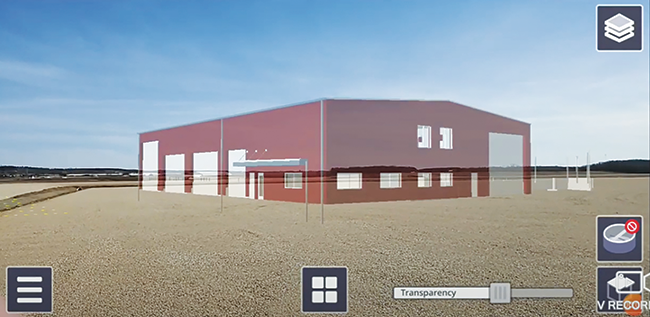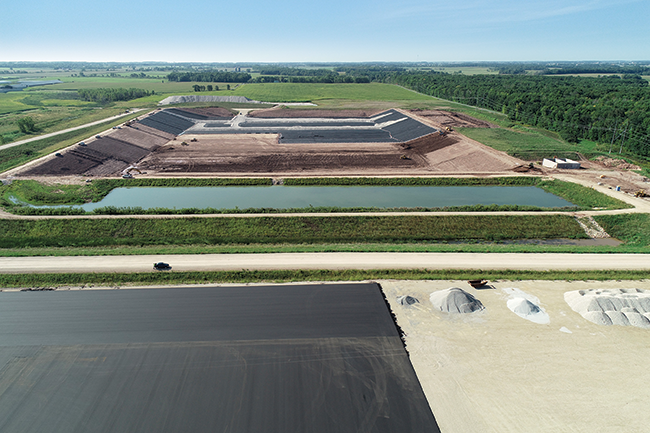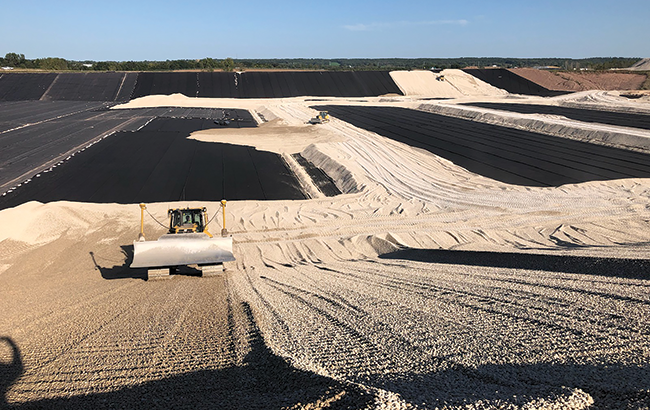With any large community project, the ability to see the complete picture and build strategic relationships are the keys to success. Planners must collaborate with various government and municipal agencies, the public, and an array of contractors who will support design, engineering, construction, and operation.
By Dan Michiels, P.E.
Planning for the development of a landfill is often a massive undertaking with significance that stretch decades into the future. A modern solid waste site must be capable of protecting the environment from millions of tons of solid waste, while generating enough capital reserves during its operation to ensure its stability long after closure.
Due to the ever-changing nature of waste generation and our ever-evolving understanding of waste decomposition, planners must maintain awareness and competency for current trends, technologies, and best practices for engineering and constructing landfills. Thankfully, waste management professionals can reduce that mountainous challenge to a mole hill by following the essentials of landfill planning—from site evaluation and budget projections to using modern technology for long-term sustainability.

Site Evaluation for a Solid Waste Facility
Whether the facility will be placed on a greenfield or existing site, understanding the past and present is imperative to evaluating the future and developing a plan. An initial site inspection provides a preliminary evaluation and identifies the necessary components to comply with locational criteria and performance standards.
Following the inspection, a siting/feasibility report is created based on the state’s criteria, which may include sensitive areas, wetlands, environmental aspects, the site’s surroundings, and noise constraints. Site-specific investigations are also established such as determining the type of soil and identifying potential waste containments.
As structured, the state refrains from permitting every opportunity for a landfill and typically requires a needs analysis to proceed with new landfill capacity considerations. The decision is made on an
as-needed basis after considering the size of a community’s population, the anticipated growth of this population, the surrounding towns and their waste contributions, industry growth within the area, other facilities that accept certain types of materials, and overall facility capacity.
A state regulator’s signature on the siting/feasibility report launches the next step—addressing the community impacted by the facility. Understanding common questions and being prepared to offer potential solutions can help build confidence and support among community stakeholders. Common areas for concern include impacts to landowners, traffic flow for both refuse carriers and residents, the number of scales needed to support anticipated traffic, and wastewater treatment practices. Growing concerns include odor and noise, as well as the facility’s greenhouse gas emissions. Discussions often lead to an agreement with the host community spanning the lifetime of the landfill, at which point a detailed plan of operation for the site is developed.

Landfill Budget and Financial Assurance
Prior to construction, both public and private organizations are advised to identify the short- and long-term costs associated with the facility. There are many variables that contribute to a design, operations, and closure budget, so it is recommended to conduct a lifecycle analysis to identify all financial factors in advance. Regulatory bodies will also require proof of owner financial assurance prior to construction. Often, this will require setting up owner-allocated funds in an environmental fund to ensure the facility will be properly closed and maintained through end of life.
An effective operations plan is based on the number of restrictions and the site-specific criteria addressed during the design phase and will need to account for the facility’s financial longevity. For solid waste facilities, this starts before a single piece of earth is moved, runs the entire operating lifetime of the facility, and extends for decades after it reaches capacity and is capped. Including pre-construction planning and post-closure care, the operating lifespan is typically more than 50 years, so the facility must earn sufficient capital and maintain diligent control of operational costs during its operation to support this extensive time frame.

Solid Waste Facility Sustainability
Environmental engineering is critical to help prevent contamination in meaningful ways. A new landfill facility will exist for the foreseeable future, not just during its operation, so it is important to understand the potential environmental impact before construction begins.
In addition, planners should consider how a site can be transformed into something useful after it is capped. Solid waste facilities often become sites for plantings and landscaping, as well as opportunities for parks, walking paths, hiking and biking trails, and more. Determining the possibilities for repurposing a landfill is critical to improve stakeholder and community involvement—especially for greenfield projects.
Greenfield sites are undeveloped areas within or outside a city and are most common on agricultural land.
They are often sought after for manufacturing plants and other commercial projects because construction is typically uncomplicated and straightforward. However, with solid waste sites, there may be opposition from nearby residents, businesses, and landowners. Having clear, open-ended communication with key stakeholders about safeguarding the environment and planning to repurpose a site for a future civic amenity can help overcome opposition and foster support.
Use Modern Technology for Landfill Development
Site planners can stay a step ahead by applying the latest technological advancements in the industry, such as helpful visualization tools like augmented reality (AR). Even when building upon or expanding existing properties, AR can help educate stakeholders during the conceptual phase by giving context to the project, including need, overall structure, and placement of facilities within the site. Using AR throughout the subsequent design phase can also help avoid unknowns, misinterpretations, and other issues during construction.
Using modern technology may not solve every problem, but it does enhance the experience, especially considering the changing demographic of decision-makers. Being able to visualize the end product in a given space has become a common expectation across industries. For environmental and infrastructure projects like solid waste facilities, it provides shared understanding and consistency for all stakeholders throughout the project.
The Key to Successful Solid Waste Site Development
With any large community project, the ability to see the complete picture and build strategic relationships are the keys to success. Planners must collaborate with various government and municipal agencies, the public, and an array of contractors who will support design, engineering, construction, and operation.
One way to simplify the process is to partner with a full-service firm to lead the planning and engineering phases and even serve as the required third-party observer during construction. Having a team that shares like-minded goals—and understands the project as a whole—leads to a more successful outcome. Following these steps can help you take on the challenge of developing a solid waste facility and still come out smelling like a rose. | WA
Dan Michiels, P.E., is a lead engineer with Foth who brings 13 years of engineering, design and construction experience on solid and liquid waste planning and permitting projects, infrastructure bidding, and construction oversight, landfill monitoring and reporting tasks, and design, bidding, construction contract administration, and field observation of solid waste facilities. He applies his extensive solid waste engineering expertise to landfill liners, cover systems, and biogas systems and facilities. Projects vary from annual environmental compliance and reporting to multimillion-dollar construction projects. Dan is a Wisconsin-licensed professional engineer with a Bachelor of Science degree in Natural Resources and Environmental Engineering from the University of Wisconsin-Madison. He can be reached at [email protected].
